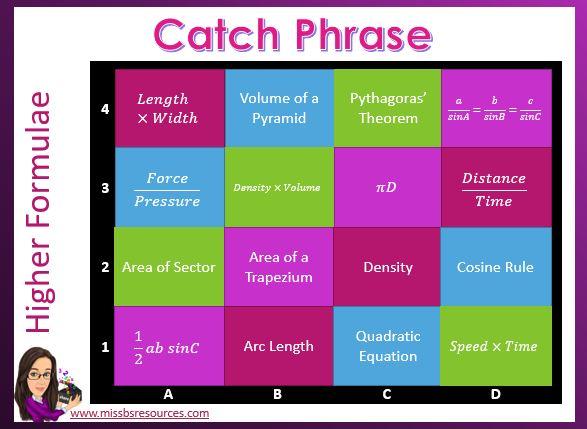Quizzing Using Catch Phrase - Revision Strategy

Catch phrase is a great quizzing tool that can be used within the classroom. It is important to continualy allow students the opportunity to retrieve information they have previously learnt. Catch phrase is a quizzing strategy I regularily use as it allows me to quickly assess a student’s understanding of a topic with either open or closed questions. Engagement levels are maxed out when we play catch phrase and it brings out the competitive side in many students. As a team game this allows for students to collaborate both their ideas and methods of answering a question, as well as building class moral. This is an ideal revision strategy for students to add to their revision toolbox when working at home.
Closed Questions
This is perhaps the easier style of questioning to use catch phrase for.
Place keywords onto the grid and ask students to provide the definitions or vice versa. This good for when the students need to remember lots of key terms and processes. The example I’ve used for this is the river processes of erosion, transport and deposition. This method works the same for when students need to remember key formulas in science and maths.
- You could ask a series of questions on the squares and ask students to provide the answers.
For example ‘Who said ….’, ‘When did …’ or ‘What happened when ….’
Open Questions
This is a little more challenging and takes confidence as a teacher to run.
Open questioning is perfect for when a student needs to memorise multiple or different facts about a key word, term or characters. Ideal for quizzing a class on the quotes they need to memorise for their GCSE English and English Literature exams. By placing the characters names on the grid students will need to remember the quotes they have personally chosen for the characters.
- You could also provide students with a series of answers for which they need to create the question for.
Purpose of revision using catch phrase
Students either as individuals or small groups answers questions to reveal part of an image. The more questions the students answer the more of the image is revealed. The winner is the person who manages to say what they see and guess the catch phrase.
How to quiz using catch phrase
Load into presenter mode. Go around the tables in an orderly manner asking them to choose a box. Use the grid references to do this such as A2 etc. This allows you to know and locate precisely which square the students means to answer. This also quizzes a students ability to read tables and coordinates. A subtle hint of numeracy across the curriculum which will inadvertently help the least able mathematicians within your class.
Once a group has provided a sufficiently correct answer click the question box. This will in turn make the question box disappear and reveal part of the catch phrase image. The students then have one chance to guess the catch phrase before you move onto the next group. The process is then repeated. I often give points for each correct answer and sometimes weight the points, so the harder the question the more points a group gains. I also then give a large amount of points to the team who guesses the catch phrase. This motivates the students to attempt the harder questions and aids the competitive element of the quizzing strategy.
I’ve included the answer to each catch phrase in the notes box, as well as answers on the second page.
The maths formulae ones can work either way with a catchphrase underneath each grid.
Foundation and Higher Maths Formulae Catch phrase


Geography - River Processes Catch phrase
English - Key Quotes from Macbeth Catch phrase
Tags: Numeracy , Numeracy across the curriculum, Numeracy4all, revision, GCSE,, New GCSE
Comments
- No comments found




Leave your comments
Login to post a comment
Post comment as a guest